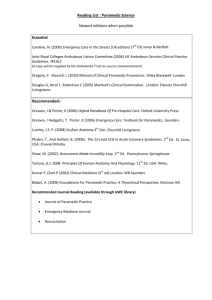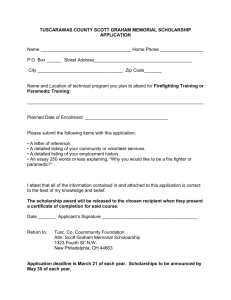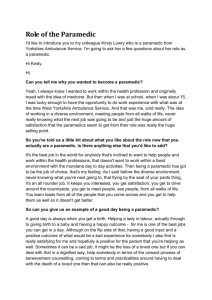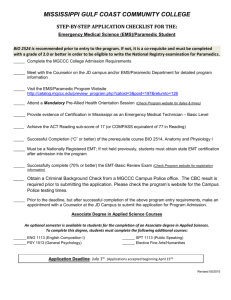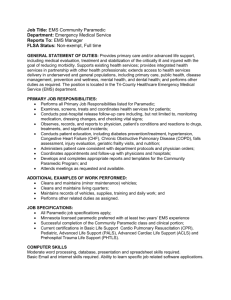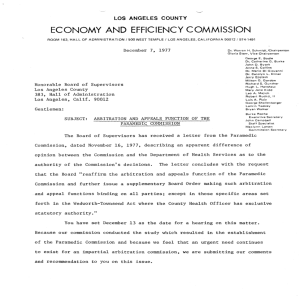module specification template
advertisement
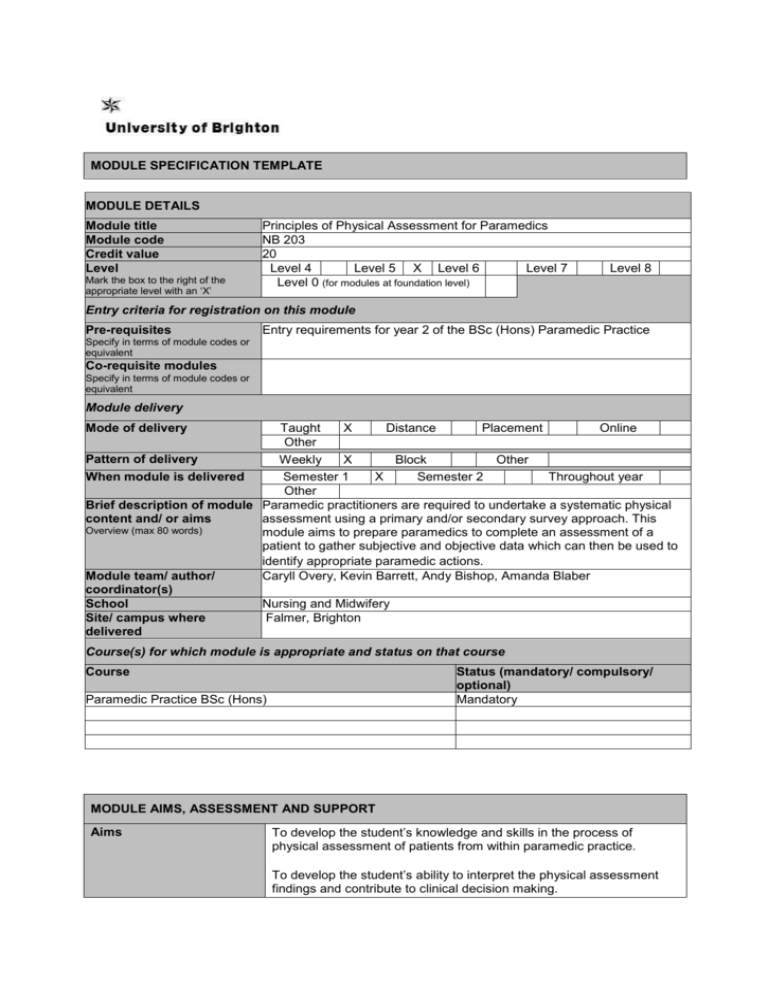
MODULE SPECIFICATION TEMPLATE MODULE DETAILS Module title Module code Credit value Level Mark the box to the right of the appropriate level with an ‘X’ Principles of Physical Assessment for Paramedics NB 203 20 Level 4 Level 5 X Level 6 Level 7 Level 0 (for modules at foundation level) Level 8 Entry criteria for registration on this module Pre-requisites Entry requirements for year 2 of the BSc (Hons) Paramedic Practice Specify in terms of module codes or equivalent Co-requisite modules Specify in terms of module codes or equivalent Module delivery Mode of delivery Taught X Distance Placement Online Other Pattern of delivery Weekly X Block Other When module is delivered Semester 1 X Semester 2 Throughout year Other Brief description of module Paramedic practitioners are required to undertake a systematic physical content and/ or aims assessment using a primary and/or secondary survey approach. This Overview (max 80 words) module aims to prepare paramedics to complete an assessment of a patient to gather subjective and objective data which can then be used to identify appropriate paramedic actions. Module team/ author/ Caryll Overy, Kevin Barrett, Andy Bishop, Amanda Blaber coordinator(s) School Nursing and Midwifery Site/ campus where Falmer, Brighton delivered Course(s) for which module is appropriate and status on that course Course Status (mandatory/ compulsory/ optional) Mandatory Paramedic Practice BSc (Hons) MODULE AIMS, ASSESSMENT AND SUPPORT Aims To develop the student’s knowledge and skills in the process of physical assessment of patients from within paramedic practice. To develop the student’s ability to interpret the physical assessment findings and contribute to clinical decision making. Learning outcomes On successful completion of the module, the student will be able to: 1. Demonstrate a safe & systematic approach when taking a structured health history for five body systems. 2. Demonstrate a safe & systematic approach when undertaking physical assessment for five body systems, using appropriate techniques and tools and terminology. 3. Identify & analyse commonly occurring abnormalities for five body systems, and recognise abnormal findings 4. Articulate & analyse the means by which patient safety may be ensured throughout the assessment and also how actions can be effectively risk managed 5. Employ effective communication and interpersonal skills and ensure patient comfort and dignity at all times • Content Overview of health history and physical assessment strategies and skills • Practical, legal and ethical aspects of physical assessment • Systematic approach to physical assessment: scene survey, primary survey (ABCDE), secondary survey (focused/detailed) and ongoing assessment as relevant for the following body systems: Respiratory, cardiovascular, neurological, abdominal, musculoskeletal, ear/nose/throat, eyes, skin, mental health • Patho-physiology of common illnesses/injuries related to paramedic practice • Investigations and referrals for common illnesses/injuries related to paramedic practice • Interventions for common illnesses/injuries related to paramedic practice Record keeping for assessment findings and actions related to paramedic practice. Learning support All students have access to the learning materials in the module area within the managed learning environment of student central. Journals: Journal of Paramedic Practice Journal of Emergency Primary Health Care Emergency Medical Services Journal of Emergency Medical Services Emergency Medicine Journal Texts: Bickley, L.S. 2012. Bates’ guide to physical examination and history taking. 11th ed. Philadelphia: Lippincott Williams & Wilkins. Blaber, A.Y. and Harris, G. ed. 2011. Assessment skills for paramedics. Maidenhead:Open university press. Bledsoe, B.E., R.S. Porter and R.A. Cherry. 2007 Essentials of paramedic care. 2nd ed. Saddle River, NJ: Pearson. Caroline, N.L. 2013. Nancy Caroline’s emergency care in the streets. 7th ed. London: Jones and Bartlett. Douglas, G., F. Nicol, and C. Robertson. 2009. Macleod’i i i s clinical examination. 12th ed. Edinburgh: Churchill Livingstone. Elling, B. and K. Elling. 2003. Principles of patient assessment in EMS. Clifton Park, NY: Thomson Delmar Learning. Gregory, P. And I. Mursell. 2010. Manual of clinical paramedic procedures. Chichester: Wiley-Blackwell. Hawthorne, L. 2011. Patient assessment practice scenarios. Sudbury: Jones and Barlett Learning. Online Resources: Helbock, M. and J.M. Jerin. 2011. Sick/not sick: a guide to rapid patient assessment. 2nd ed. Sudbury: Jones and Barlett Learning. Talley, N.J. 2010. Clinical examination: a systematic guide to physical diagnosis. 6th ed. Oxford: Elsevier Churchill Livingstone. http://www.med.ucla.edu/wilkes/intro.html http://www.emsvillage.com/education_center/Breath_Sounds/index.cfm http://www.cvmbs.colostate.edu/clinsci/callan/breath_sounds.htm http://www.meddean.luc.edu/lumen/MedEd/medicine/pulmonar/pd/step 29e.htm http://www.lung-auscultation.com www.auscultationassistant.com http://www.paramedic-resource-centre.com/ http://www.emsresponder.com/ http://www.templejc.edu/dept/ems/Pages/PowerPoint.html http://www.defrance.org/ Teaching and learning activities Details of teaching and learning activities Lectures will be provided by faculty staff and invited multi-disciplinary clinical staff Teaching methods include: key note lectures, group debate, demonstrations and practice of assessment techniques, Student Central e-learning activities, DVDs, anatomical models, tutorials and practice OSCEs All students will be required to identify a clinical mentor who will supervise development of practice in the paramedic practice. Hours of study: 42 hours taught lectures (7 days) 18 hours e-learning 40 hours 200 hours total Allocation of study hours (indicative) Study hours Where 10 credits = 100 learning hours SCHEDULED 42 taught lectures (7 days) 18 hours e-learning 60 GUIDED INDEPENDENT STUDY independent learning 40 PLACEMENT clinical hours 100 TOTAL STUDY HOURS 200 Assessment tasks Details of assessment for this module Assignment weighting The student will undertake two assessment tasks: practice (50%) and theory (50%). Both assessment tasks must achieve a minimum of 40% in order to pass the module. Theory 50% E-exam 2 hours Multiple choice examination based upon content covered in the module including interpretation of assessment findings and appropriate actions related to paramedic practice. Practice 50% Objective Structured Clinical Examination (OSCE) The student will be assessed in physical assessment related to paramedic practice of the following systems: Cardiovascular, Respiratory, Neurological, Abdominal, and Musculoskeletal and these will be marked according to the SNM clinical examination criteria Types of assessment task1 % weighting Indicative list of summative assessment tasks which lead to the award of credit or which are required for progression. (or indicate if component is pass/fail) WRITTEN Multiple Choice Exam 50% COURSEWORK N/A PRACTICAL Objective Structured Clinical Examination (OSCE) 50% EXAMINATION INFORMATION Area examination board Joint BSc (Hons) Nursing, BSc (Hons) Paramedic Practice & Foundation Degree. Refer to Faculty Office for guidance in completing the following sections External examiners Name Position and institution Date appointed Date tenure ends Sally Ann Arnold-Jones Paramedic Lecturer, Coventry University September 2013 August 2017 QUALITY ASSURANCE Date of first approval 08.07.2009 Only complete where this is not the first version Date of last revision 02.04.2014 Only complete where this is not the first version Date of approval for this version Version number 02.04.2014 2 1 Set exercises, which assess the application of knowledge or analytical, problem-solving or evaluative skills, are included under the type of assessment most appropriate to the particular task. Modules replaced Specify codes of modules for which this is a replacement Available as free-standing module? Yes No X
